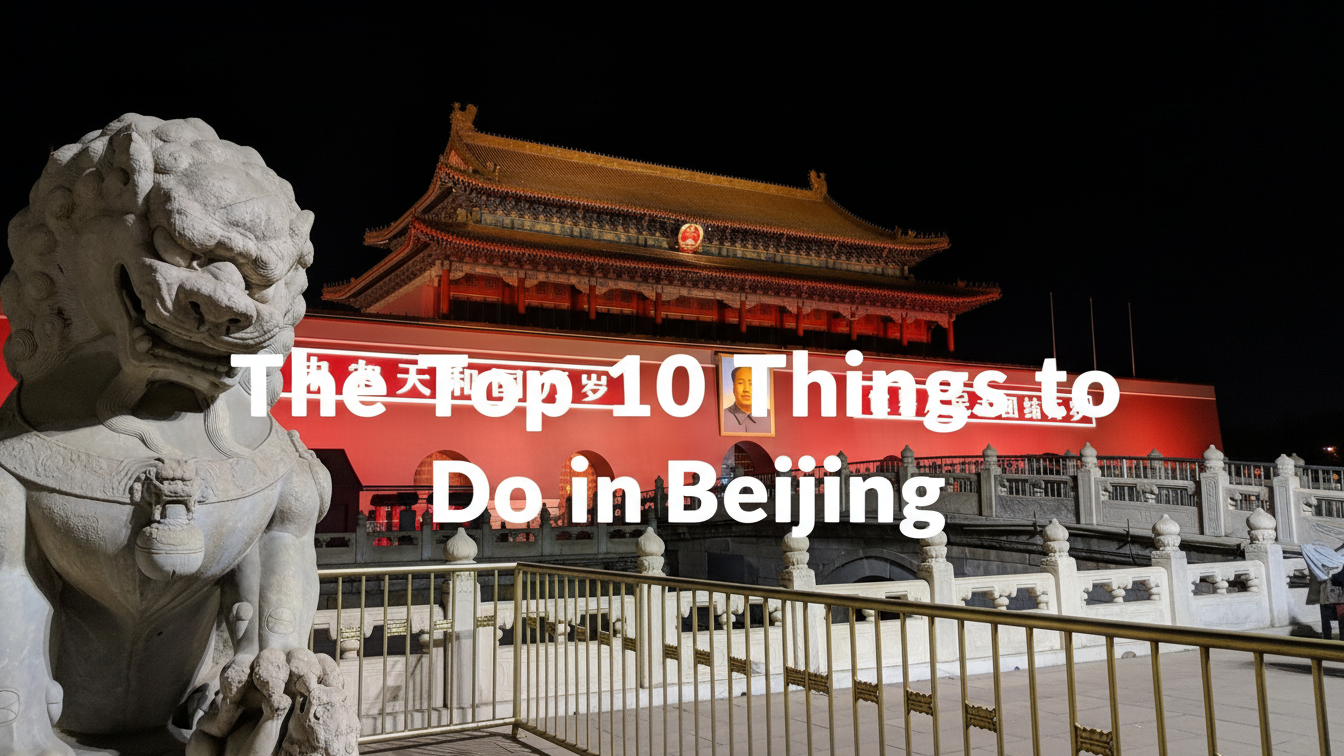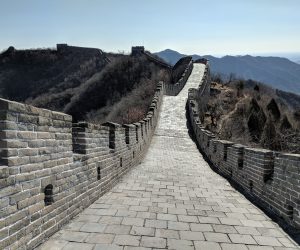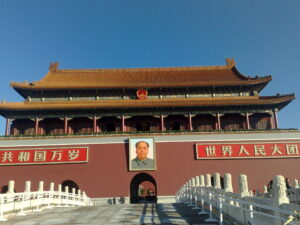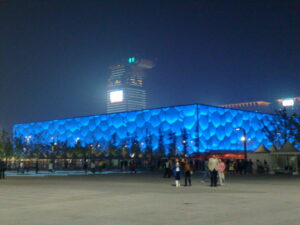China’s capital city, Beijing, is a special destination that provides a fusion of ancient and modern culture. The Great Wall of China, the Forbidden City, and the Temple of Heaven are just a few of the city’s well-known attractions. The cultural and architectural wonders of the past are reflected in these historical sites.
The Forbidden City, a UNESCO World Heritage Site that was the imperial palace for Chinese monarchs from the Ming dynasty to the end of the Qing dynasty, is one of the must-see locations in Beijing. The palace offers a picture of the imperial lifestyle with its distinctive fusion of traditional Chinese architecture and designs.
Another incredible place to visit is the 13,000-mile-long Great Wall of China. An engineering and building marvel illustrates the wall’s strategic value in earlier times.
In addition to its historical sites, Beijing also offers a contemporary side. The city is a centre for technical innovation and advancement, as seen by the sophisticated infrastructure, cutting-edge transportation options, and thriving commercial districts.
In conclusion, travelling to Beijing is a rewarding experience that provides the ideal blend of modernism and ancient history. From ancient sites to cutting-edge conveniences, the city has a lot to offer visitors.
Here are the top 10 things to do and see when visiting Beijing:
The Great Wall of China
is a network of defenses that encircles northern China for more than 13,000 kilometers. The most well-known portion was built during the Ming dynasty, which ruled China from the 14th through the 17th centuries. It was erected over the course of several centuries by numerous Chinese dynasties.
The Great Wall was first constructed as a line of defense against invaders and later became an important commercial and military route. It is regarded as one of the greatest engineering achievements in human history. Portions of the wall were constructed through rocky mountain slopes and across enormous desert expanses.
As a symbol of Chinese history and culture, the Great Wall of China is now a well-liked tourist destination. Hiking around the wall allows visitors to take in the breath-taking scenery and architectural design, which includes watchtowers, ramparts, and other defensive elements. The Great Wall is still a powerful reminder of China’s historical accomplishments in building and engineering.
If you would like to book a tour to see the Great Wall of China, click here or on the Get Your Guide image below to select from one of our preferred suppliers.
Visit the Forbidden City in Beijing
For more than 500 years, the Ming and Qing dynasties’ royal palace was the Forbidden City in the centre of Beijing. It is a significant representation of Chinese history and culture and the largest remaining palace complex in the world.
The Forbidden City, which has a floor area of more than 720,000 square meters, was constructed in the early 15th century. There are about 980 structures total, including halls, palaces, gardens, and courtyards. With elaborate carvings, vibrant decorations, and stunning paintings, the Forbidden City’s architecture is a fusion of traditional Chinese style with imperial grandeur.
As a UNESCO World Heritage Site and well-liked tourist destination, the Forbidden City is now. In addition to taking in cultural performances and exhibitions, visitors can explore the sizable complex and learn about China’s imperial past. As one of the world’s great civilizations, China has left behind a rich cultural heritage that is still evident at the Forbidden City.
Visit the Temple of Heaven
A spectacular piece of architecture called The Temple of Heaven is situated in Beijing, China, in the southern region. The emperors used the structure, which was constructed in 1420 during the Ming Dynasty, as a location for sacrifice ceremonies and prayers for abundant harvests.
A superb illustration of Chinese architecture and design is the Temple of Heaven. Its 273 hectares are made up of a number of buildings and constructions, such as the Imperial Vault of Heaven, the Circular Mound Altar, and the Hall of Prayer for Good Harvests.
With its triple-gabled circular form and blue-tiled roof, the Hall of Prayer for Good Harvests is the most recognisable building in the Temple of Heaven. The Imperial Vault of Heaven is a more compact building, yet its interior is no less magnificently adorned. The emperors would make offerings and carry out their rites at the Circular Mound Altar, which has a distinctive circular pattern.
The Temple of Heaven is now a well-liked tourist spot and a UNESCO World Heritage Site. While strolling around the lovely grounds and exploring the temple’s numerous buildings and monuments, visitors may learn more about China’s rich history and culture.
Visit the Summer Palace in Beijing
It is a UNESCO World Heritage Site and a well-liked tourist site in China, and it is situated in the northwest suburbs of Beijing. The Qing Dynasty rulers used it as a summer retreat and imperial garden when it was first constructed in the 18th century.
Over 700 acres of gorgeous gardens, temples, pavilions, and lakes can be found in the Summer Palace. With elaborate carvings, vibrant decorations, and striking paintings, its building blends traditional Chinese design with European influences.
The Kunming Lake, which spans more than 500 acres and is encircled by picturesque hills and gardens, is one of the Summer Palace’s highlights. Visitors can walk along the lake’s picturesque walkways and bridges or take a boat ride on it.
The Summer Palace offers a look into China’s rich history and culture today and is a well-liked site for both tourists and residents. It is a must-see sight in Beijing due to its stunning surroundings and magnificent architecture.
If you would like to book a tour to see the Summer Palace, click here or on the Viator image below to select from one of our preferred suppliers.
Hop on Hop off Bus Tours in Beijing
Hop on, hop off Beijing bus tours are a practical and effective way to see the main sights and monuments of the city. Because the buses stop at predetermined locations where you can get off and explore the area before getting back on to continue your trip, these excursions let you see the city at your own leisure.
A hop-on-hop-off bus the prominent sights in Beijing are frequently included in bus tours, including Tiananmen Square, the Forbidden City, the Temple of Heaven, the Summer Palace, and many others. You may get a thorough explanation of the background and significance of each place through the audio guides, which are available in several different languages and are installed in the buses.
These excursions are ideal for first-time visitors to Beijing who want to see the city’s top attractions without having to worry about figuring out how to use the public transport system or flag down a cab. Since the buses follow a set timetable, you may organise your day properly and spend as much time as possible visiting the city.
In conclusion, Hop on Hop off. Beijing bus tours are a terrific way to see the city’s top sights at your own leisure while still enjoying the benefits of a guided tour.
If you would like to book a ticket on a hop on hop off bus tour in Beijing, click here or on either the Big Bus Tours or CitySightseeing banners below to select from one of our preferred suppliers.
Visit the Tiananmen Square
The famous landmark Tiananmen Square is situated in the centre of Beijing, China. It is one of the largest public squares in the world, covering an area of more than 100 acres, and it has had a tremendous impact on Chinese history. However, it is most well-known for what happened on June 4, 1989.
On that day, tens of thousands of pro-democracy demonstrators flocked to Tiananmen Square to call for political change and increased freedom. Chinese authorities used force, bringing in the military to evacuate the square. Although the precise number of victims is unknown, it is thought that hundreds, if not thousands, of demonstrators perished.
In China, the Tiananmen Square massacre is still a very sensitive subject, and the government has made great attempts to stifle any mention of or memorialization of the tragedy. Despite this, the protests and the ensuing crackdown continue to be remembered in China and throughout the world. The events of June 4th, 1989 continue to serve as a sobering reminder of the strength of authoritarian governments and the necessity of defending democratic principles and human rights.
Visit the Hutongs in Beijing
Beijing, China is home to a special variety of winding streets known as “hutongs.” They connect the traditional courtyard homes of Siheyuan with a network of pathways and courtyards. Since the Yuan Dynasty, which started in the 13th century, there have been these alleys. Historically, the majority of Beijing’s residents have lived mostly in the Hutongs. They now provide tourists with a window into the city’s rich past and present.
The Hutongs are an essential component of Beijing’s cultural history, and in recent years, protecting them has taken on more importance. Modern cafes, bars, restaurants, and shops may be found in numerous Hutongs that have been restored to their former splendour. In stark contrast to the contemporary city core, they offer a distinctive ambience. Experience Beijing’s traditional way of life by taking a guided tour, a rickshaw tour, or a walking tour of the Hutongs.
The Hutongs provide an opportunity to study Beijing’s culture, history, and traditional buildings. They are a must-see for everyone who wants to experience the vibrant cultural legacy of the city.
Visit the 798 Art District
In the Dashanzi neighborhood of Beijing, there is a hip cultural hotspot called the 798 Art District. It is an industrial complex that has been converted into a bustling hub for modern art and culture from its previous life as a military electronics manufacturing. Due to the district’s abundance of galleries, studios, exhibition halls, cafes, and shops, both visitors and residents enjoy visiting there.
The distinctive architecture of the neighbourhood, many of which were once factories but have since been refurbished to include contemporary architectural elements, is a clear indication of the area’s past as a factory complex. The contrast of modern art and industrial history creates a distinctive and fascinating ambiance that draws tourists from all over the world.
The 798 Art District not only has a large number of galleries and art spaces, but it also regularly holds festivals, plays, and other types of cultural events. The 798 Art District is a must-visit location in Beijing whether you are an experienced art enthusiast or just searching for a distinctive cultural experience.
The National Stadium (Bird’s Nest) in Beijing
The National Stadium, also referred to as the Bird’s Nest, is a notable sports venue in Beijing. Jacques Herzog and Pierre de Meuron, architects, created it for the 2008 Summer Olympics and Paralympics. The moniker “bird’s nest” refers to the stadium’s distinctive architectural style.
The stadium is constructed of steel and concrete and can accommodate 80,000 spectators. Its exterior shell, which is made up of intertwined steel beams that resemble a lattice, is what makes it stand out from other structures. This latticework was created to resemble the look of conventional Chinese ceramics.
The National Stadium has served as the location for a number of other significant sporting occasions and concerts in addition to the Summer Olympics and Paralympics in 2008. The stadium, a prominent Beijing landmark, has come to represent China’s modernization and rising stature internationally.
Since it was built, the National Stadium has grown to be a well-liked tourist destination, drawing travellers from all over the globe to admire its distinctive architecture and appreciate its historical significance.
The Beijing Opera
A historic type of Chinese theatre that started in Beijing in the 18th century is the Beijing Opera, sometimes referred to as Peking Opera. It tells tales from Chinese mythology and history using singing, acting, acrobatics, and martial skills.
The opera is well-known for its lavish costumes, makeup, and music, which incorporates a distinctive singing style called “jingju.” To communicate emotions and the inner thoughts of the characters, the vocalists sing in a high-pitched, nasal voice.
The opera includes elaborate choreography, acrobatics, dancing, and singing in addition to music and singing. To create a visually attractive performance, the actors use vibrant props and special effects.
The Beijing Opera is now regarded as a national asset of China and is a part of the UNESCO Intangible Cultural Heritage. The unique fusion of music, drama, and acrobatics that it incorporates continues to draw crowds to its performances throughout China and other parts of the world.
Festivals in Beijing
China’s capital city, Beijing, is a centre of cultural diversity and holds a number of festivals throughout the year that highlight the nation’s customs, fine arts, and vivacious spirit.
The Spring Festival, commonly known as Chinese New Year, is one of Beijing’s most well-known celebrations. Vibrant parades, lion dances, fireworks, and family get-togethers mark this major festival, which ushers in the lunar calendar.
Another important event is the Lantern event, which takes place on the fifteenth day of the Lunar New Year. People enjoy cultural performances, traditional foods, and colourful lantern displays while releasing lanterns into the sky.
Family get-togethers and moon appreciation take place during the Mid-Autumn Festival, commonly referred to as the Moon Festival. People congregate to partake in customary festivities, admire lantern displays, and eat mooncakes.
Beijing also organises the International Cultural and Tourism Festival, which features art exhibits, musical performances, and cultural displays from many parts of China to highlight the city’s rich cultural legacy.
These festivals in Beijing offer a singular chance to become immersed in the customs of the nation, sample local cuisine, take in stunning performances, and learn more about China’s rich cultural legacy.
In conclusion, Beijing is an ancient city with fascinating history and the cultural heritage, tourist attractions should not be missed, and you will definitely enjoy your visit.






















